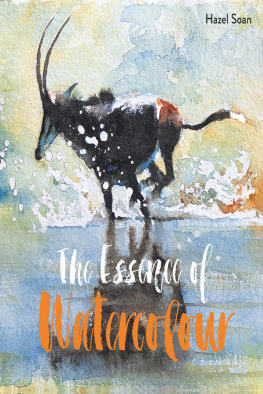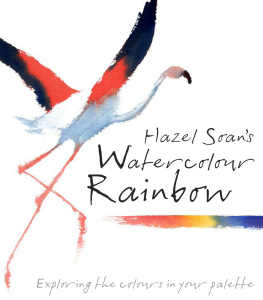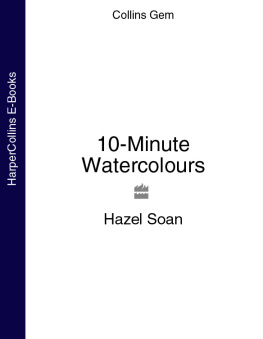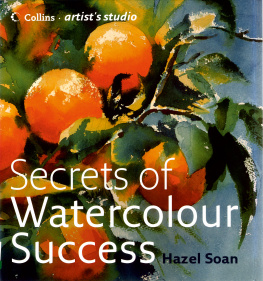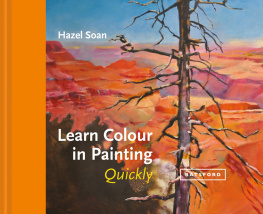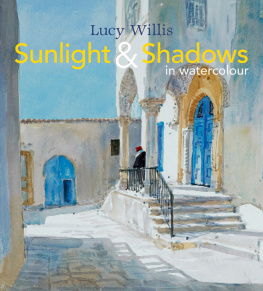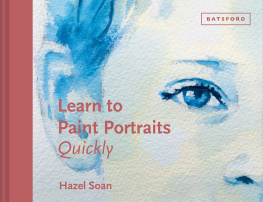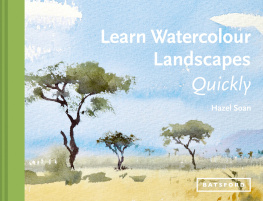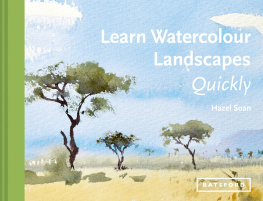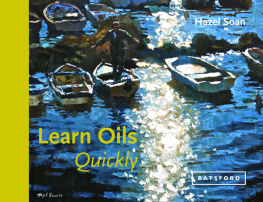The Essence of
Watercolour

Belonging
33 x 25 cm (13 x 10 in)
Watercolour is the perfect medium for capturing moments in time.

Ripening in Tuscany
30 x 30 cm (12 x 12 in)
The organic colours and overlapping tints of watercolour breathe life into the apricots ripening on the tree.
The Essence of
Watercolour
Hazel Soan

Dedication: To all my readers.
Acknowledgements: Huge thanks go to Cathy Gosling for her faith in my writing and to Kristy Richardson who has been a joy to work with. Thanks go to Winsor & Newton for responding to my questions so effectively. Thank you also to Angela and Janice for their help and to Lorraine McCreery for the photo reference on . A special thank you to my husband and son for their love.
Contents
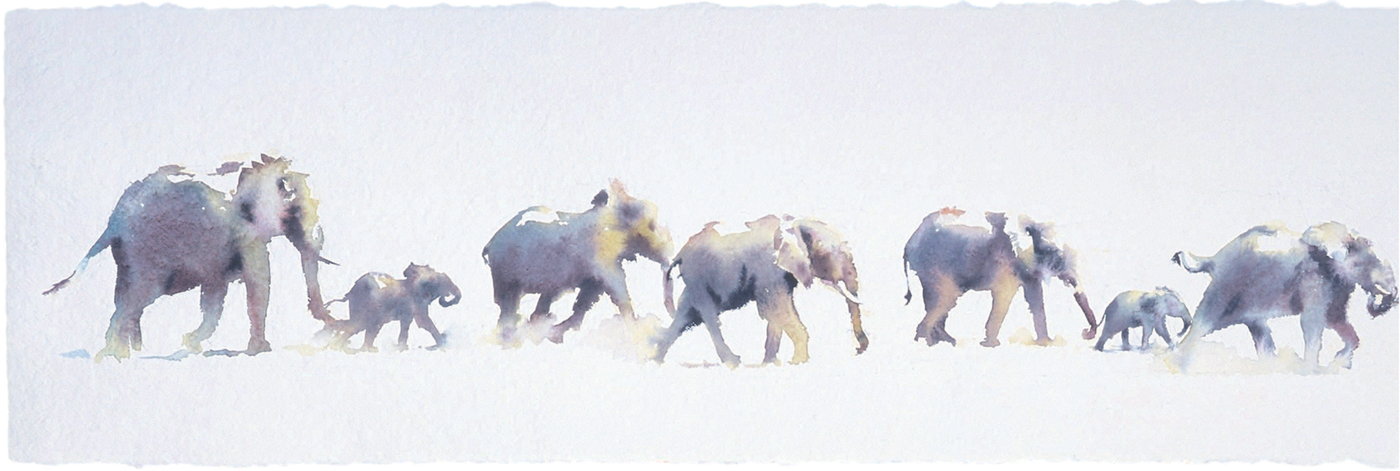
Wild Intervals
25 x 102 cm (10 x 40 in)
Watercolour can suggest so much within its gentle evocative blends.
The Appeal of Watercolour

Sunlight bathes the Cloisters
35.5 x 51 cm (14 x 20 in)
The transparent, radiant tints of watercolour convey light with a mystery hard to emulate in other painting media.
It is easy to see why watercolour is so appealing. The brilliance of the pigments, the transparency of the colours, their exotic names, and the infinite variety of radiant blends, combine to offer a medium of unsurpassed quality. Mixed with water, laid on paper, easy to carry, and quick to apply, watercolour is supremely practical for anyone wanting to paint. Shimmering light and delicious darks are the province of watercolour, adding to the joy of working with such a satisfying medium. All these qualities are the distinctive characteristics of this versatile medium. They give it a unique identity and are the essence of watercolour.
A Captivating Medium
The more I paint with watercolour the more impressed I become with the medium. Its intrinsic beauty, and the brilliance, radiance and transparency of its pigments, seem to offer more than the opportunity to make paintings of breathtaking beauty. Choosing the pigments, brushes and paper is an aesthetic experience in itself; mixing colours in the palette is immensely satisfying; making brushmarks is a thrill; and even watching paint dry becomes a fascination as the flowing colours blend. Researching the science of watercolours action on paper for this book has made me fall in love with the medium even more! So perfectly suited to its purpose, the less you order it around the more ably it performs, and the more you put your trust in the materials the finer the reward.

Shoes With Attitude
51 x 51 cm (20 x 20 in)
Watercolour has the ability to transform something ordinary even these shoes into something magical. The transparent, fresh, brilliant colours makes this lovely medium so appealing.

A Big Hat in Oxford Street
15 x 15 cm (6 x 6 in)
The gentle diffusion of colours, the untouched white paper for the highlights, and the irregular edge to the brushstroke, are three of watercolours most-loved characteristics.
Lay it and Leave it
Yet, with all these benefits watercolour remains a very challenging medium. When confronted with a sheet of white paper there is often fear in the first brushstroke, the adrenaline pumps, the stomach churns, anxiety is high. Why?
Unlike oils or acrylics, watercolour is essentially a kinetic medium the wet pigments move on the paper. This means the painter may not always feel, or be, in control of the medium and this can be intimidating. Once you understand what might happen, however, you can harness this action and encourage it to head in the direction you desire. Soon you will trust the perfected pigments, silky sables and tactile papers to uphold their promise, and the results reflected in your paintings will increase your confidence.
Watercolour welcomes decisiveness, it does not really like prevarication. My motto has become Lay it and leave it. Plan the painting, mix the pigment, lay the brushstrokes and then leave the watercolour to work its own magic on the paper. This is the essence and art of watercolour painting.

Castles in the Sand
13 x 18 cm (5 x 7 in)
Many of the delightful effects of watercolour occur after the brush has left the paper.
Full of Surprises
Watercolour often surprises. It is not an exact science. The artist sets the painting in motion, but the outcome is not certain. The watercolour takes on a life of its own and anything can happen. Sometimes the result surpasses the artists hopes, but there is also the risk of failure this is all part of the thrill. The aim of this book is to help you gain confidence through greater knowledge of what you can expect from this remarkable medium. To encourage you to exploit the properties of watercolour to the full and to make you less afraid of strength of colour and brazen brushstroke, practise the techniques using the Explore spreads at the end of each chapter. Knowing how to achieve clarity, transparency and radiance will put you in the driving seat.
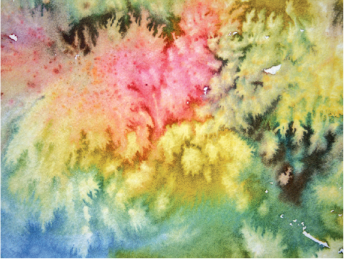
Fynbos (detail)
7.5 x 10 cm (3 x 4 in)
Salt dropped into a wash creates delightful patterns as the water evaporates.
The Thrill of the Chase
My understanding of how watercolour behaves is gleaned through many years of practice, and I am still learning. I do not believe I can conquer this medium and it is that challenge that keeps my adrenaline running high when faced with a sheet of white paper. Almost every painting I make is an experiment, a chance to find out something more about watercolour. I love this medium. I love the intense concentration it demands, the bliss of being totally caught up in the painting, the lure of such beautiful colours, such sensuous brushes, such tempting paper. For me the time spent mixing in the palette, waiting for the right moment to add even the tiniest touch of pigment is just as exciting as making the brushstrokes on the paper. The finished result is no more important than the joy of the painting process.
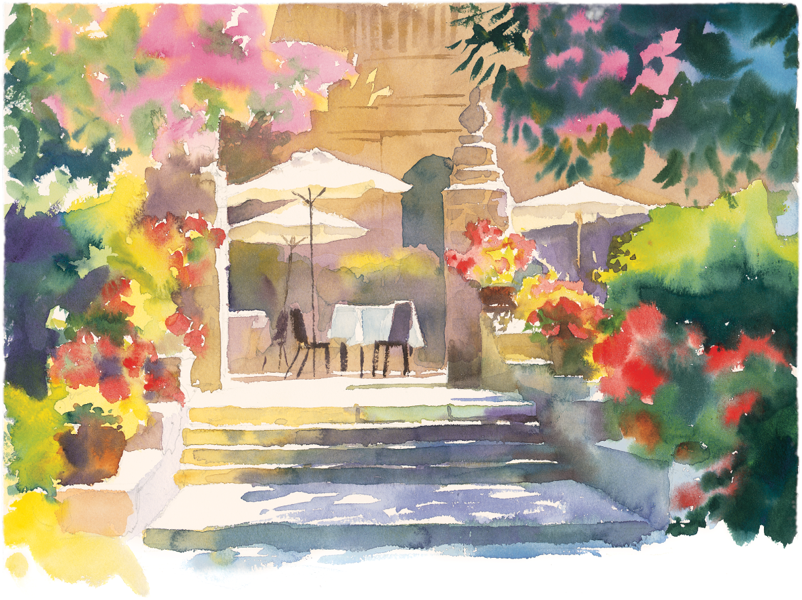
Next page
